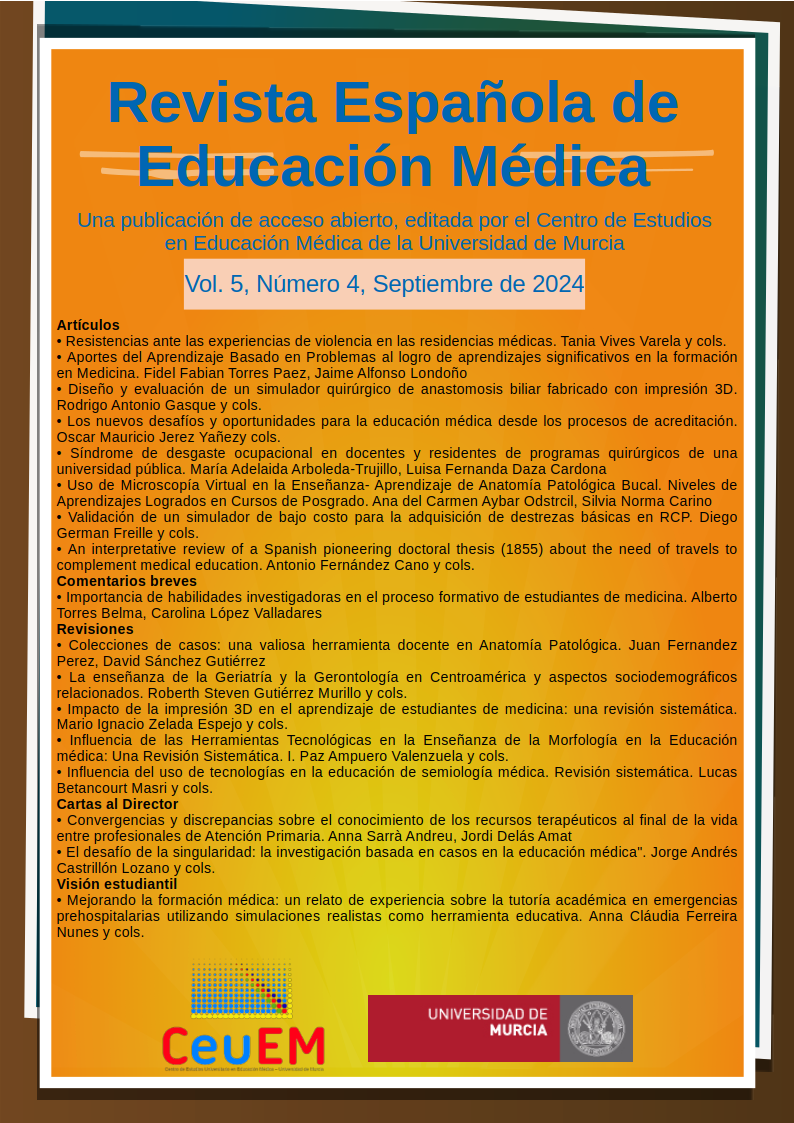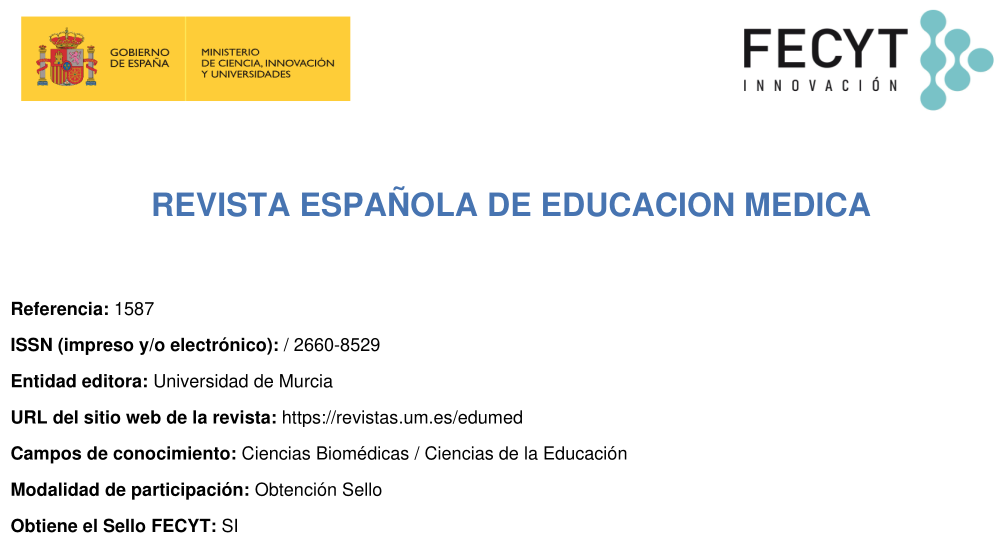Impacto de la impresión 3D en el aprendizaje de estudiantes de medicina: una revisión sistemática.
Abstract
The use of 3D printing has spread throughout a multitude of fields, including medical education, being used from human anatomy teaching to surgical technique training due to the benefits of “Hands-on learning.” The objective of this study was to clarify the impact of 3D printing on medical student education, as well as to determine in which areas of their curriculum it has been implemented. For this purpose, we conducted a systematic review of the literature. We used the following databases: PubMed, CINAHL, PsycINFO, ERIC, Web of Science, and SCOPUS, using the following four concepts: “3D Printing” AND “Medical Education” AND “Outcome of Education” AND “Higher Education.” Publications in English and Spanish were considered. A total of 3,326 studies were identified up to October 2023 (705 duplicates). Using the PRISMA 2020 protocol and the software COVIDENCE, four authors reviewed the results and selected those meeting the proposed inclusion and exclusion criteria. 2561 studies were excluded, identifying 60 studies for full-text reading. Of these, 34 met the inclusion criteria, which were finally reviewed and synthesized by the authors. Our results show a tendency to study the educational role of 3D Printing in the areas of anatomy, various pathologies, radiology, and simulation. When comparing 3D printing with 2D models, there was evidence of better post-intervention scores within 3D groups. As for cadaveric models, 3D printing showed better results in anatomy teaching. However, some studies did not show significant differences; however, none reported inferiority of 3D printing as a teaching tool. Finally, a limited number of studies have been conducted on its impact on long-term learning. Overall, there is evidence that the introduction of 3D printing in various areas of medical education has a positive impact on learning.
Downloads
Metrics
-
Abstract1143
-
pdf (Español (España))701
-
pdf701
References
Fleming C, Sadaghiani MS, Stellon MA, Javan R. Effectiveness of Three-Dimensionally Printed Models in Anatomy Education for Medical Students and Resident Physicians: Systematic Review and Meta-Analysis. J Am Coll Radiol JACR. 2020 Oct;17(10):1220–9. https://doi.org/10.1016/j.jacr.2020.05.030
Chytas D, Johnson EO, Piagkou M, Tsakotos G, Babis GC, Nikolaou VS, et al. Three-dimensional printing in anatomy teaching: current evidence. Surg Radiol Anat. 2020 Jul 1;42(7):835–41. https://doi.org/10.1007/s00276-020-02470-2
Leung G, Pickett AT, Bartellas M, Milin A, Bromwich M, Shorr R, et al. Systematic review and meta-analysis of 3D-printing in otolaryngology education. Int J Pediatr Otorhinolaryngol. 2022 Apr 1;155:111083. https://doi.org/10.1016/j.ijporl.2022.111083
Brumpt E, Bertin E, Tatu L, Louvrier A. 3D printing as a pedagogical tool for teaching normal human anatomy: a systematic review. BMC Med Educ. 2023 Oct 20;23(1):783. https://doi.org/10.1186/s12909-023-04744-w
O’Brien C, Souza CA, Sheikh A, Miguel O, Wood T. Use of tracheobronchial tree 3-dimensional printed model: does it improve trainees’ understanding of segmentation anatomy? A prospective study. 3D Print Med. 2021 Jan 6;7(1):2. https://doi.org/10.1186/s41205-020-00092-3
Asif A, Lee E, Caputo M, Biglino G, Shearn AIU. Role of 3D printing technology in paediatric teaching and training: a systematic review. BMJ Paediatr Open. 2021 Dec;5(1):e001050. https://doi.org/10.1136/bmjpo-2021-001050
Ye Z, Jiang H, Bai S, Wang T, Yang D, Hou H, et al. Meta-analyzing the efficacy of 3D printed models in anatomy education. Front Bioeng Biotechnol. 2023 Feb 20;11:1117555. https://doi.org/10.3389/fbioe.2023.1117555
Schwartz DL, Tsang JM, Blair KP. The ABCs of how we learn: 26 scientifically proven approaches, how they work, and when to use them. First edition. New York, NY: W.W. Norton & Company, Inc; 2016. 367 p. (Norton books in education).
Page MJ, McKenzie JE, Bossuyt PM, Boutron I, Hoffmann TC, Mulrow CD, et al. The PRISMA 2020 statement: an updated guideline for reporting systematic reviews. BMJ. 2021 Mar 29;372:n71. https://doi.org/10.1186/s13643-021-01626-4
Lim KHA, Loo ZY, Goldie SJ, Adams JW, McMenamin PG. Use of 3D printed models in medical education: A randomized control trial comparing 3D prints versus cadaveric materials for learning external cardiac anatomy. Anat Sci Educ. 2016 May 6;9(3):213–21. https://doi.org/10.1002/ase.1573
Mogali SR, Chandrasekaran R, Radzi S, Peh ZK, Tan GJS, Rajalingam P, et al. Investigating the effectiveness of three‐dimensionally printed anatomical models compared with plastinated human specimens in learning cardiac and neck anatomy: A randomized crossover study. Anat Sci Educ. 2022 Nov;15(6):1007–17. https://doi.org/10.1002/ase.2128
Kong X, Nie L, Zhang H, Wang Z, Ye Q, Tang L, et al. Do 3D Printing Models Improve Anatomical Teaching About Hepatic Segments to Medical Students? A Randomized Controlled Study. World J Surg. 2016 Aug;40(8):1969–76. https://doi.org/10.1007/s00268-016-3541-y
Chen S, Pan Z, Wu Y, Gu Z, Li M, Liang Z, et al. The role of three-dimensional printed models of skull in anatomy education: a randomized controlled trail. Sci Rep. 2017 Apr 3;7(1):575. https://doi.org/10.1038/s41598-017-00647-1
Yang MY, Tseng HC, Liu CH, Tsai SY, Chen JH, Chu YH, et al. Effects of the individual three-dimensional printed craniofacial bones with a quick response code on the skull spatial knowledge of undergraduate medical students. Anat Sci Educ. 2023;16(5):858–69. https://doi.org/10.1002/ase.2269
Tanner JA, Jethwa B, Jackson J, Bartanuszova M, King TS, Bhattacharya A, et al. A Three‐Dimensional Print Model of the Pterygopalatine Fossa Significantly Enhances the Learning Experience. Anat Sci Educ. 2020 Sep;13(5):568–80. https://doi.org/10.1002/ase.1942
Yi X, Ding C, Xu H, Huang T, Kang D, Wang D. Three-Dimensional Printed Models in Anatomy Education of the Ventricular System: A Randomized Controlled Study. World Neurosurg. 2019 May;125:e891–901. https://doi.org/10.1016/j.wneu.2019.01.204
Chen Y, Qian C, Shen R, Wu D, Bian L, Qu H, et al. 3D Printing Technology Improves Medical Interns’ Understanding of Anatomy of Gastrocolic Trunk. J Surg Educ. 2020 Sep;77(5):1279–84. https://doi.org/10.1016/j.jsurg.2020.02.031
Li Z, Li Z, Xu R, Li M, Li J, Liu Y, et al. Three-dimensional printing models improve understanding of spinal fracture—A randomized controlled study in China. Sci Rep. 2015 Jun 23;5(1):11570. https://doi.org/10.1038/srep11570
Yan M, Huang J, Ding M, Wang J, Ni J, Wu H, et al. Three-Dimensional Printing Model Enhances Correct Identification and Understanding of Pelvic Fracture in Medical Students. J Surg Educ. 2023 Mar 1;80(3):331–7. https://doi.org/10.1016/j.jsurg.2022.10.016
Wu AM, Wang K, Wang JS, Chen CH, Yang XD, Ni WF, et al. The addition of 3D printed models to enhance the teaching and learning of bone spatial anatomy and fractures for undergraduate students: a randomized controlled study. Ann Transl Med. 2018 Oct;6(20):403–403. https://doi.org/10.21037%2Fatm.2018.09.59
Ebbing J, Jäderling F, Collins JW, Akre O, Carlsson S, Höijer J, et al. Comparison of 3D printed prostate models with standard radiological information to aid understanding of the precise location of prostate cancer: A construct validation study. PLOS ONE. 2018 Jun 25;13(6):e0199477. https://doi.org/10.1371/journal.pone.0199477
Youman S, Dang E, Jones M, Duran D, Brenseke B. The Use of 3D Printers in Medical Education with a Focus on Bone Pathology. Med Sci Educ. 2021 Apr 1;31(2):581–8. https://doi.org/10.1007%2Fs40670-021-01222-0
Su W, Xiao Y, He S, Huang P, Deng X. Three-dimensional printing models in congenital heart disease education for medical students: a controlled comparative study. BMC Med Educ. 2018 Dec;18(1):178. https://doi.org/10.1186/s12909-018-1293-0
Lau I, Sun Z. The role of 3D printed heart models in immediate and long-term knowledge acquisition in medical education. Rev Cardiovasc Med. 2022 Jan 17;23(1):1. https://doi.org/10.31083/j.rcm2301022
Karsenty C, Guitarte A, Dulac Y, Briot J, Hascoet S, Vincent R, et al. The usefulness of 3D printed heart models for medical student education in congenital heart disease. BMC Med Educ. 2021 Dec;21(1):480. https://doi.org/10.1186/s12909-021-02917-z
Wang Z, Liu Y, Luo H, Gao C, Zhang J, Dai Y. Is a Three-Dimensional Printing Model Better Than a Traditional Cardiac Model for Medical Education? A Pilot Randomized Controlled Study. Acta Cardiol Sin. 2017 Nov;33(6):664–9. https://doi.org/10.6515%2FACS20170621A
Wu C, Luo M, Liu Y, Dai R, Zhang M, Zhong Y, et al. Application of a 3D-printed eye model for teaching direct ophthalmoscopy to undergraduates. Graefes Arch Clin Exp Ophthalmol. 2022 Jul 1;260(7):2361–8. https://doi.org/10.1007/s00417-021-05538-w
Smith CF, Tollemache N, Covill D, Johnston M. Take away body parts! An investigation into the use of 3D‐printed anatomical models in undergraduate anatomy education. Anat Sci Educ. 2018 Jan;11(1):44–53. https://doi.org/10.1002/ase.1718
Lane JC, Black JS. Modeling Medical Education: The Impact of Three-Dimensional Printed Models on Medical Student Education in Plastic Surgery. J Craniofac Surg. 2020 Jun;31(4):1018. https://doi.org/10.1097/scs.0000000000006567
Al-Badri N, Touzet-Roumazeille S, Nuytten A, Ferri J, Charkaluk ML, Nicot R. Three-dimensional printing models improve long-term retention in medical education of pathoanatomy: A randomized controlled study. Clin Anat. 2022;35(5):609–15. https://doi.org/10.1002/ca.23878
AlAli AB, Griffin MF, Calonge WM, Butler PE. Evaluating the Use of Cleft Lip and Palate 3D-Printed Models as a Teaching Aid. J Surg Educ. 2018 Jan 1;75(1):200–8. https://doi.org/10.1016/j.jsurg.2017.07.023
Nicot R, Druelle C, Chazard E, Roland-Billecart T, Nuytten A, Richard F, et al. Three-Dimensional Printing Model Enhances Craniofacial Trauma Teaching by Improving Morphologic and Biomechanical Understanding: A Randomized Controlled Study. Plast Reconstr Surg. 2022 Mar;149(3):475e–84e. https://doi.org/10.1097/prs.0000000000008869
Cai B, Rajendran K, Bay BH, Lee J, Yen C. The Effects of a Functional Three‐dimensional (3D) Printed Knee Joint Simulator in Improving Anatomical Spatial Knowledge. Anat Sci Educ. 2019 Nov;12(6):610–8. https://doi.org/10.1002/ase.1847
Ben Awadh A, Clark J, Clowry G, Keenan ID. Multimodal Three-Dimensional Visualization Enhances Novice Learner Interpretation of Basic Cross-Sectional Anatomy. Anat Sci Educ. 2022 Jan;15(1):127–42. https://doi.org/10.1002/ase.2045
Hojo D, Murono K, Nozawa H, Kawai K, Hata K, Tanaka T, Oba K, Ishihara S. Utility of a Three-Dimensional Printed Pelvic Model for Lateral Pelvic Lymph Node Dissection Education: A Randomized Controlled Trial. J Am Coll Surg. 2019 Dec; 229(6): 552-559.e3. https://doi.org/10.1016/j.jamcollsurg.2019.08.1443
Copyright (c) 2024 Servicio de Publicaciones de la Universidad de Murcia

This work is licensed under a Creative Commons Attribution-NonCommercial-NoDerivatives 4.0 International License.
The works published in this magazine are subject to the following terms:
1. The Publications Service of the University of Murcia (the publisher) preserves the economic rights (copyright) of the published works and favors and allows them to be reused under the use license indicated in point 2.
2. The works are published under a Creative Commons Attribution-NonCommercial-NoDerivative 4.0 license.
3. Self-archiving conditions. Authors are allowed and encouraged to disseminate electronically the pre-print versions (version before being evaluated and sent to the journal) and / or post-print (version evaluated and accepted for publication) of their works before publication , since it favors its circulation and earlier diffusion and with it a possible increase in its citation and reach among the academic community.



















